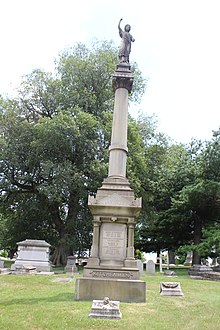James Kitchenman
James Kitchenman (November 19, 1825, Barnsley, England – December 25, 1909, Philadelphia, Pennsylvania, USA) was one of the foremost manufacturers of Kensington, Philadelphia in the 1800s.[1][2]
James Kitchenman | |
|---|---|
| Born | November 19, 1825 Barnsley, England |
| Died | December 25, 1909 (aged 84) Philadelphia, Pennsylvania, USA |
| Known for | Textile manufacturing |
| Spouse(s) | Margaret Crawford |
Early life
James Kitchenman was born in Barnsley, England, on November 19, 1825, to Richard Kitchenman and Phoebe Foster Kitchenman.[3] He was a young lad when he accompanied his parents on the long voyage across the Atlantic to the new world. His financial resources in youth were very limited and necessitated his securing a position when a young lad that he might provide for his own support.[1]
Career
Dyes
Kitchenman therefore sought and secured a position in a dye house and as he became familiar with the business determined to engage in the same line some day on his own account. At length his unfaltering industry and careful expenditure made this course possible and he established a dyeing business, which he conducted for a considerable period in a most successful manner.[1]
Carpets
.jpg)
In fact his prosperity in that connection enabled him to engage in the manufacture of carpets with Samuel Horner and his brother at Amber and Letterly streets. After the dissolution of that partnership he turned his attention to the manufacture of ingrain carpets and woolen and worsted yarns, having a large plant at Huntingdon and Jasper streets.[1]
Subsequently, he was joined in a partnership by George M. Neal in the manufacture of body Brussels and Axminster carpets, the enterprise being conducted under the firm style of Kitchenman & Neal. With the growth of the business he kept increasing his facilities, adding to his mill until he had one of the largest and finest manufacturing enterprises in Kensington.[1] He used the Markland loom of 1868, and later the more efficient Crompton & Knowles ingrain looms.[2]
Hosiery
He also took up the manufacture of hosiery, which he carried on a large scale at Amber and Letterly streets. The attractiveness of design and the excellence of quality in all of his manufactured products brought him substantial success, his sales annually increasing until he became recognized as one of the most prominent manufacturers of eastern Pennsylvania. About fifteen years prior to his demise he retired from active business, although he still retained his mill at Jasper and Huntingdon streets. He has come to be classed with those men whose intelligently directed industry and effort have numbered them with the capitalists of Philadelphia.[1]
Family

Mr. Kitchenman was married in Philadelphia in the 1850s to Miss Margaret Crawford, a daughter of William Crawford, who was an early resident of this city. They became the parents of five children: Anna, Clara, Margaret, Elizabeth and Mary. Mary married G. S. Coyne[4][2] of the George S. Coyne Chemical Co.[1] Among their descendants are the artist Elizabeth Kitchenman Coyne[5] and Republican former member of the U.S. House of Representatives James K. Coyne III.[4]
James Kitchenman was a member of the Independent Order of Odd Fellows at one time and he attended the Bethel Presbyterian church in North Philadelphia.[1] His political allegiance was given to the Democratic party.[6] In 1885, he was proposed as a candidate for Sheriff of Philadelphia, by a committee from the Knights of Labor, who applauded him as a Democrat, businessman, and "friend of labor" who sought to protect workingmen's rights to fair wages.[7] He was a public-spirited citizen, as was manifested by his support of the various projects and movements instituted for the general good. Moreover, he was kindly and charitable and few men have realized more fully the responsibility of wealth.[1]
His last years were spent in honorable retirement from business in an attractive home at 1024 West Lehigh Avenue, Philadelphia, where he remained until his death, which occurred on Christmas Day of 1909.[1] He is buried in Laurel Hill Cemetery.[3][2]
Hexamer General Surveys
The Hexamer General Surveys document the floor plans for a number of Kitchenman's factories over time.
- Hexamer General Surveys, Volume 6, Plate 464: James Kitchenman's Carpet Manufactory
- Hexamer General Surveys, Volume 7, Plate 648: James Kitchenman's Worsted Factory
- Hexamer General Surveys, Volume 12, Plate 1085: James Kitchenman's Worsted Factory
- Hexamer General Surveys, Volume 13, Plate 1200: James Kitchenman's Worsted Factory
- Hexamer General Surveys, Volume 17, Plate 1629: James Kitchenman's Carpet Factory
- Hexamer General Surveys, Volume 30, Plate 2941: James Kitchenman's Carpet Factory
Sources
![]()
References
- Oberholtzer, Ellis Paxson (1912). Philadelphia, A History of the City and its People; A Record of 225 Years. 4. Philadelphia: S. H. Clark. p. 418.
- "Death of James Kitchenman". American Carpet and Upholstery Journal. 28 (January): 63. 1910.
- "James Kitchenman". Find A Grave. Retrieved 28 October 2019.
- "History". George S. Coyne Chemical Co., Inc. Retrieved 28 October 2019.
- "Elizabeth Kitchenman Coyne (1892 - 1971)". AskArt. Retrieved 17 March 2018.
- Scranton, Philip (2002). Figured tapestry : production, markets and power in Philadelphia textiles. Cambridge, England: Cambridge University Press. pp. 98–99. ISBN 9780521521369. Retrieved 28 October 2019.
- "Sanders for Sheriff". The Times (Phila). October 2, 1885. Retrieved 6 February 2020.